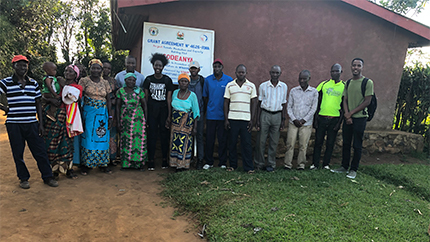Note: The University of Nebraska–Lincoln's Water for Food Global
SEEDS student learning community, hosted by the Daugherty Water for Food
Global Institute, is focused on professional development in
entrepreneurship, agriculture and sustainable development. As part of
their studies, students visited Rwanda in Summer 2019 to research
agriculture entrepreneurship models. The following is one of several
guest posts from students' about their experiences.
Irrigated land can produce 2.3 times more than non-irrigated lands according to a report by the World Food Organization. The Rwandan government recognizes that irrigation is one of the cornerstones for yield maximization. The country has set a lofty goal of doubling its irrigated land to 100,000 hectares by 2024. The government initiated a subsidy program for small scale irrigation technologies (drip, sprinkler, and rain-gun kits) — or SSITs. Farmers pay half the acquisition cost and the rest is covered by the government.
Despite the subsidy program, the cost of acquisition is still too high for smallholder farmers. According to the Rwanda Agricultural Board (RAB) equipment costs are around $1500 per hectare, with the average farm size in the country around half a hectare. Different business models have been established to ease the adoption of irrigation to farmers, but reducing the acquisition costs to be affordable to farmers is still a challenge.

This summer, two other Rwandan students at the University of Nebraska–Lincoln and myself worked with the Daugherty Water for Food Global Institute (DWFI) to understand the key players in Rwanda’s agriculture sector. We set out to identify if irrigation, as a service, can be a successful model for small scale irrigation.
Over a span of two months, we visited farmers to observe and analyze their irrigation systems. We conducted interviews with farmers; governmental and non-profit organizations; and private institutions to help us understand the industry and its challenges. We also connected with irrigation professionals by attending several conferences. Our main objectives were to identify available gaps or opportunities in the irrigation sector, and to design a feasible and scalable business model for small scale irrigation as a service.
RAB defines a smallholder farmer as the one who produces crops on less than ten hectares. However, we found that farmers who operate on less than a hectare are much less likely to use irrigation, and the challenges are reduced as the size of land increases. Many of these smallholder farmers have to provide food to their families, which leaves little to no food to sell on the market to make a profit.
Additionally, smallholder farmers face the challenges of inaccessibility to stable markets and water sources, as well as high operating costs. Irrigation of crops is often disregarded because of high costs of both the equipment and the storage of vegetables and fruits. Unless the farmer has a consistent market, they will lose money because of high production costs. The cost of drilling wells is very high, so surface water is the main source for irrigating fields. However, apart from the marshlands and some parts of the Eastern province, surface water is generally a scarce resource. Plus, fuel costs are high for motor pumps used for irrigation.
Based on successful stories of farmer cooperatives, we found that farmers working together is the key to successful agriculture for smallholder farmers. We visited many cooperatives that have unlocked access to irrigation by applying for grants or using savings from cooperatives members to buy the systems.

Working in cooperative enables farmers to share operating costs like hiring an agronomist or accountant. For an individual farmer, these services would be inaccessible on their own. We also found that for irrigation as service to be successful, there should be a strong organization of farmers who live close to each other. This could facilitate the sharing of equipment, resulting in a lower cost and simplified payment process. Sharing of field condition information will also be easier, which is critical in making key management decisions like irrigation scheduling. Plus, sharing the cost of renewable energy in the form of solar-powered irrigation could be more sustainable for farmers in the long.
It was a tremendous experience to conduct a study on irrigation in Rwanda. We learned much about Rwanda’s agriculture sector, including the challenges faced by farmers and different measures taken by the government to help them. It also gave us a chance to develop our interpersonal skills especially related to communication. At first, it was a challenge to initiate an interactive discussion with farmers, but we got better through the process. That been said, I would like to extend my gratitude to DWFI for providing us with this internship opportunity to gain knowledge in the field. We are highly appreciative of DWFI’s mentorship and its enormous support in terms of resources throughout our summer internship.
References
1. Dowgert, M. F., & Fresno, C. A. (2010, February). The impact of irrigated agriculture on a stable food supply. In Proceedings of the 22nd Annual Central Plains Irrigation Conference, Kearney, NE (pp. 24-25).
2. MINAGRI 2014 Report: Implementation Strategy for Small Scale Irrigation

